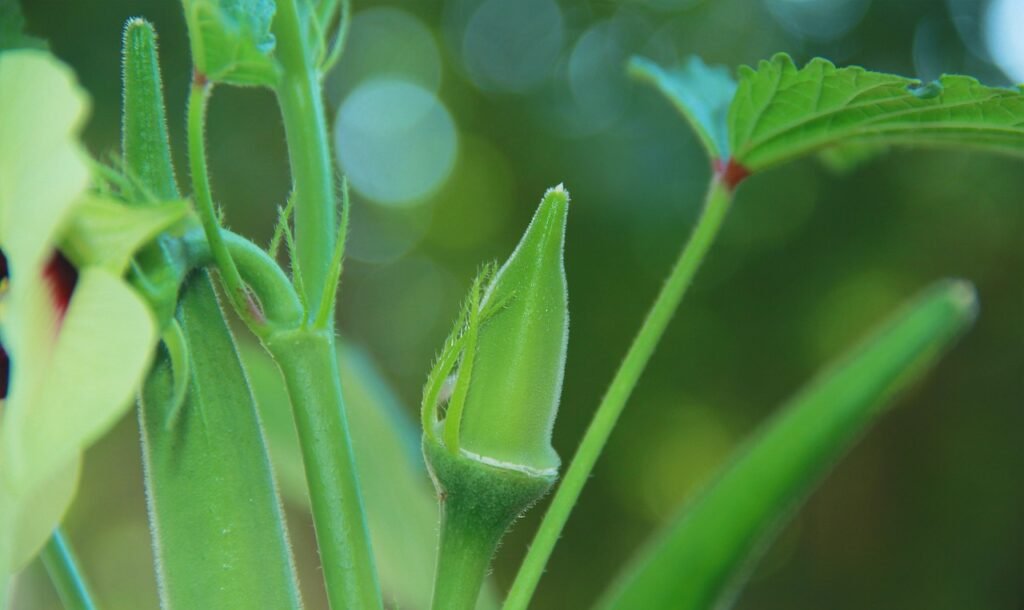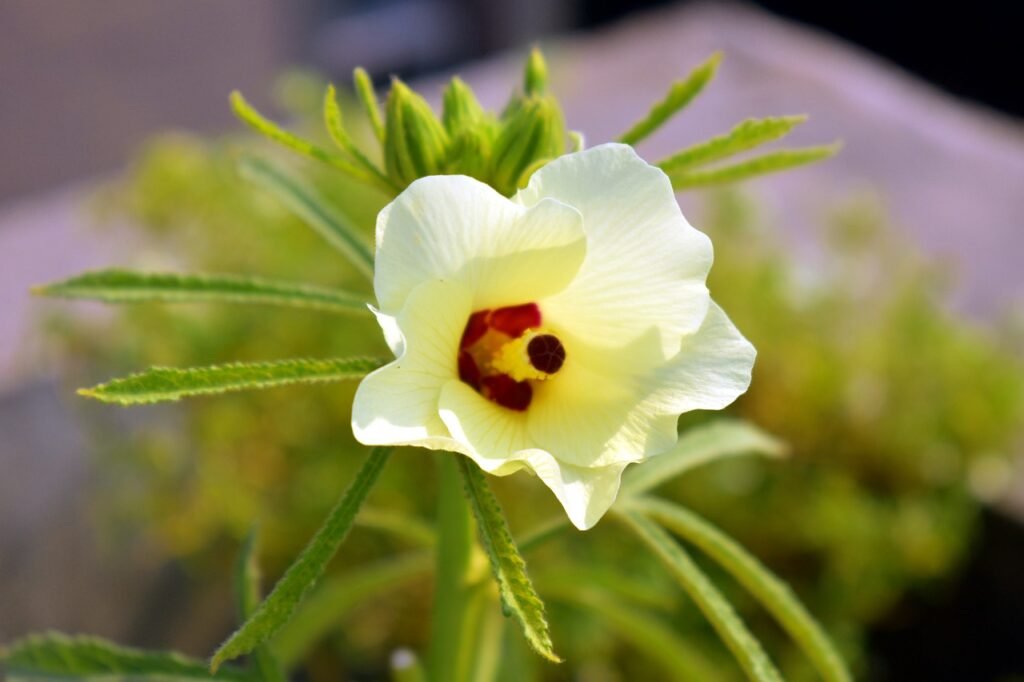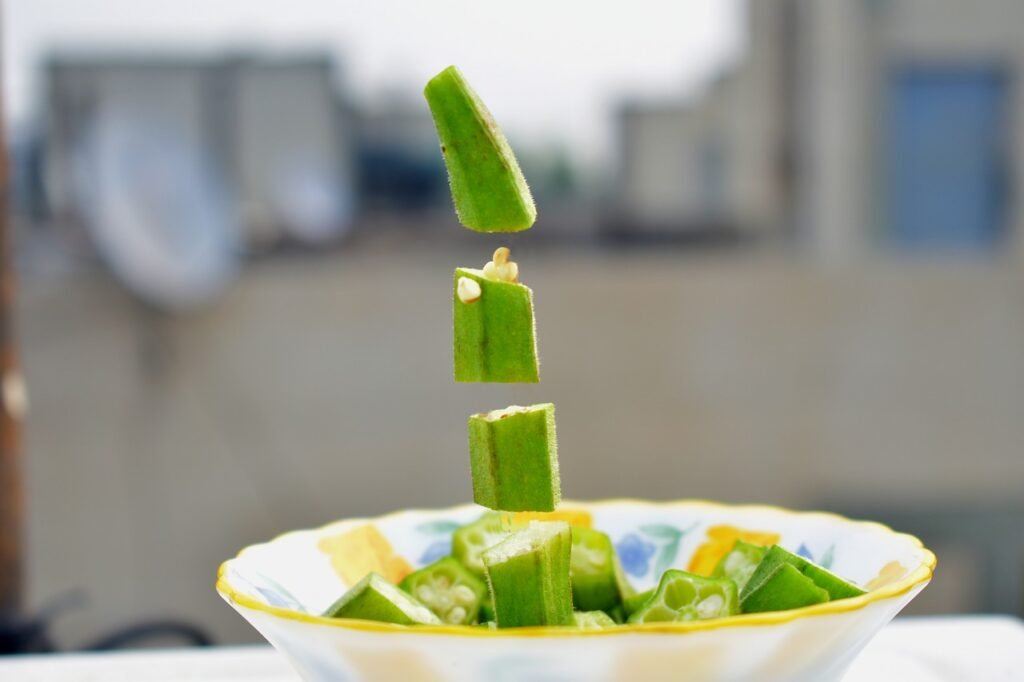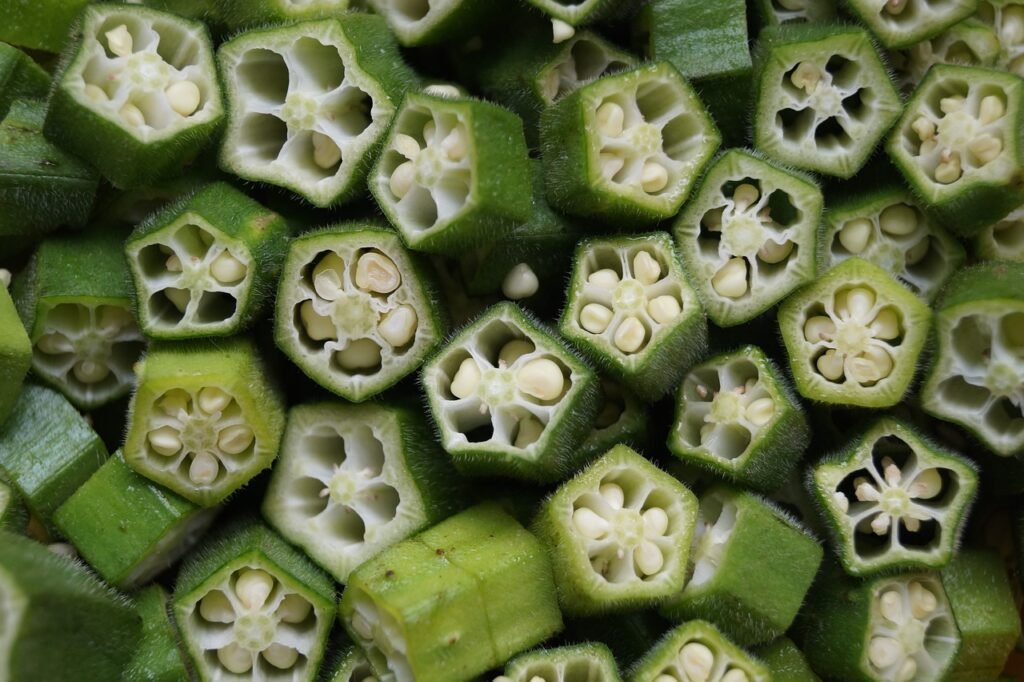Okra Growing Guide From Seed To Harvest To Health Benefits

Are you curious about okra and how to grow it from seed to harvest? Interested in learning about the optimal growing conditions for this versatile vegetable?
In this comprehensive guide, we will cover everything you need to know about okra, from its health benefits to different ways to prepare it. We will also discuss common pests and diseases to watch out for.
So sit back, relax, and let’s explore the world of okra together!
What is Okra?
Okra, also known as lady’s fingers, is a warm-season vegetable that belongs to the mallow family. It is prized for its edible green pods and is cultivated for its nutritional value and culinary versatility.
Okra plants are characterized by their tall, sturdy stems and large, showy flowers that eventually give way to the iconic elongated pods. The pods are filled with small, round seeds and have a slightly mucilaginous texture, making them suitable for thickening soups and stews.
Okra has a long history of cultivation in various parts of the world, dating back centuries. It is known for its significant cultural importance in Southern cuisine, where it is a staple ingredient in dishes like gumbo and jambalaya.

How to Grow Okra from Seed?
Growing okra from seed is a rewarding experience that requires proper planning, care, and attention to detail. Starting okra seeds indoors or directly in the garden can lead to a successful harvest of this versatile vegetable.
- Selecting high-quality okra seeds is the first step in ensuring a strong start. Look for certified organic seeds or reputable seed suppliers to guarantee the best germination rates.
- When it comes to planting depth, sow the seeds about half an inch deep in well-draining soil enriched with compost. Okra thrives in warm climates, so ensure your okra receives full sunlight for at least 6-8 hours a day. Regular watering is crucial, especially during hot weather, but be mindful not to overwater as okra plants prefer slightly dry conditions.
Selecting The Best Variety of Okra to Grow
Choosing the right okra varieties for your home garden can greatly influence both the yield and the quality of your harvest. Here are some popular varieties that thrive in a range of climates:
- Clemson Spineless: Known for its tender, spine-free pods and consistent production. It’s a favorite for its easy harvesting and excellent flavor.
- Emerald: Valued for its smooth, round pods and resistance to disease, making it a robust choice for gardeners.
- Baby Bunch: An excellent compact variety that still produces abundantly, perfect for those with limited space.
- Red Velvet: Offers striking red pods that add a pop of color to your garden and dishes, alongside a unique flavor profile.
Each variety has its own unique flavor and texture, making it important to consider your culinary preferences and gardening conditions when selecting which types of okra to grow.
What are the Optimal Growing Conditions for Okra?
To ensure the optimal growth of okra plants, it is essential to provide them with the right conditions. Adequate sunlight, well-draining soil, consistent watering, and appropriate fertilization are key factors for a successful okra harvest.
- Okra thrives best in loamy soil with a pH level between 6.0 and 7.0. Soil rich in organic matter promotes healthy root development.
- Planting okra seeds at a depth of around 1 inch helps establish strong roots.
The growing season for okra typically begins in late spring and extends through summer. During hotter months, watering should be frequent but not excessive to prevent waterlogged soil and root rot. Adjusting fertilization based on plant growth stages contributes to maximizing nutrient uptake and overall plant health.

Caring For The Okra Plant
Caring for okra plants in your home garden requires some attention to detail to ensure healthy growth and abundant yield. Here are the best ways to care for okra:
- Sunlight: Okra loves the sun. Plant your okra in a spot that receives at least six hours of full sunlight each day. This warmth is crucial for their growth.
- Soil: Ensure the soil is well-draining and rich in organic matter. A pH between 6.5 and 7.0 is ideal. Before planting, enrich your soil with compost to support healthy growth.
- Watering: Regular watering is essential, especially during flowering and pod development. Aim for about 1 inch of water per week, increasing slightly during very hot weather.
- Spacing: Give okra plants plenty of space to grow. Plant seeds or seedlings about 12 to 18 inches apart in rows that are 3 feet apart to ensure adequate air circulation and sunlight.
- Fertilizing: Feed okra plants with a balanced fertilizer after the first harvest to encourage continued production.
- Pest Management: Keep an eye out for pests like aphids and flea beetles. Use insecticidal soap or neem oil as needed to manage these pests.
By following these care guidelines, your okra plants will thrive, providing you with a plentiful harvest throughout the growing season.
How to Harvest Okra?
Harvesting okra at the right time is crucial to ensure the best flavor and texture. Knowing when and how to pick the pods can maximize your yield and enjoyment of this nutritious vegetable.
- To determine the ideal time for harvesting okra, it is recommended to pick the pods when they are about 2-3 inches long.
- At this stage, they are tender and flavorful. A sharp knife or pruning shears are commonly used tools for harvesting; ensure to cut the pods above the cap without damaging the plant.
- Regular harvesting every 2-3 days encourages continuous pod production, enhancing plant productivity.
- Remember to handle harvested okra with care to prevent bruising and store them in a cool, dry place or refrigerate for prolonged freshness.

What are the Health Benefits of Okra?
Okra offers a myriad of health benefits due to its rich nutritional profile. From boosting the immune system to aiding in digestion and weight management, this vegetable is a powerhouse of essential nutrients and compounds.
It is a great source of vitamins C and K, as well as minerals like magnesium, manganese, and folate, all of which play vital roles in various bodily functions.
Okra is packed with dietary fiber, which promotes a healthy digestive system and helps regulate blood sugar levels.
The antioxidant properties of okra contribute to reducing inflammation and combating oxidative stress, thereby supporting overall well-being and potentially lowering the risk of chronic diseases.
Rich in Nutrients and Antioxidants
Okra stands out for being a nutrient-dense vegetable rich in antioxidants, vitamins, and minerals that are essential for overall health and well-being.
These antioxidants found in okra, such as beta-carotene and flavonoids, play a crucial role in neutralizing harmful free radicals in the body, thereby reducing oxidative stress and lowering the risk of chronic diseases.
Okra is a powerhouse of vitamins A, C, and K, which are vital for supporting a strong immune system, promoting healthy skin, and aiding in blood clotting.
The mineral content of okra, including magnesium, calcium, and potassium, helps in maintaining proper nerve function, muscle contraction, and bone health.
May Help Lower Blood Sugar Levels
Research suggests that okra may aid in blood sugar control, making it a potentially beneficial vegetable for individuals managing diabetes or seeking to stabilize their glucose levels.
The fiber content in okra plays a crucial role in regulating blood sugar levels by slowing down the absorption of sugar in the body, which can prevent spikes and crashes in blood glucose. Okra’s antioxidant properties help reduce inflammation and oxidative stress, both of which are linked to insulin resistance and diabetes. With its low glycemic index and high levels of essential nutrients like vitamin C, magnesium, and folate, okra can be a valuable addition to a diabetic-friendly diet, promoting overall health and wellness.

Can Improve Digestive Health
The fiber-rich content of okra makes it a valuable asset for digestive health, promoting gut function, regularity, and overall gastrointestinal well-being.
Okra is packed with essential nutrients such as vitamin C, vitamin K, and folate, all of which contribute to the effective functioning of the digestive system. Its high fiber content aids in maintaining healthy bowel movements and supporting the growth of beneficial gut bacteria. By enhancing gut motility, okra ensures that waste moves efficiently through the digestive tract, preventing issues like constipation. The mucilage in okra acts as a prebiotic, nourishing the gut flora and fostering a balanced and thriving microbiome for optimal nutrient absorption.
May Have Anti-Cancer Properties
Certain compounds found in okra have been linked to potential anti-cancer properties, suggesting a protective role against the development and progression of cancerous cells.
These compounds, particularly the antioxidants present in okra, play a crucial role in scavenging harmful free radicals that can damage cells and DNA, leading to the initiation of cancer.
The immune-boosting effects of okra’s nutrients support the body’s natural defense mechanisms, aiding in the prevention of abnormal cell growth.
Studies have revealed that okra contains high levels of vitamin C, beta-carotene, and other potent antioxidants, which together contribute to reducing oxidative stress and inflammation, both key factors in cancer protection and overall cellular health.
Can Help Improve Heart Health
The heart-healthy nutrients present in okra, such as antioxidants, vitamins, and minerals, play a crucial role in promoting cardiovascular wellness and reducing the risk of heart disease.
Okra is rich in vital nutrients like vitamin C, fiber, and potassium, which contribute to lower blood pressure and improved heart health. The antioxidants in okra help combat oxidative stress, preventing damage to heart cells and reducing inflammation in the cardiovascular system.
Including okra in your diet can aid in improving circulation, supporting overall heart function, and potentially reducing the risk of developing cardiovascular ailments. Its mineral content, including magnesium and calcium, further enhances its cardiovascular benefits by maintaining proper heart rhythm and strengthening cardiac health.
How to Store Okra?
Properly storing okra is essential to maintain its freshness, flavor, and nutritional value. Whether storing it in the refrigerator or preserving it for later use, following the right methods can extend the shelf life of this versatile vegetable.
- Refrigeration is a common method for short-term okra storage, as it helps maintain the vegetable’s crispness. When refrigerating okra, ensure it is kept in a perforated plastic bag to allow for proper air circulation.
- Freezing is another effective technique for preserving okra for longer periods. Before freezing, blanch the okra by briefly immersing it in boiling water and then cooling it in ice water. This process helps retain the okra’s color and texture.
- Canning okra is a great way to have readily available okra for recipes throughout the year. When canning, it is crucial to use proper canning methods and techniques to ensure food safety and quality preservation.
What are the Different Ways to Prepare Okra?

Okra offers a versatile canvas for culinary exploration, with a myriad of delicious recipes and cooking methods that showcase its unique flavor and texture. From stir-fries to stews, okra lends itself to a wide range of culinary delights.
One popular way to enjoy okra is by preparing it in a tasty gumbo, a savory Southern dish that combines okra with a mix of vegetables, meats, and spices for a flavorful meal. Alternatively, okra can be pickled for a tangy and crunchy snack, or breaded and fried to create crispy okra fries. In Mediterranean cuisine, okra is often featured in dishes like bamia, a stew made with tomatoes, lamb, and okra, highlighting its ability to absorb rich flavors. Whether roasted, grilled, or sautéed, okra never fails to add a delightful touch to any dish.
Sauteed Okra
Sauteed okra, with its crispy texture and savory flavor, is a delightful dish that caters to vegan and vegetarian preferences. The simple preparation and quick cooking time make it a popular choice for a nutritious and flavorful meal.
Okra, also known as lady’s fingers, brings a unique element to the table with its natural sliminess that helps thicken dishes.
To create a delicious sauteed okra, start by washing and patting dry the okra pods. Trim the ends and slice them into rounds. In a hot pan, sauté sliced onions and garlic until fragrant, then add the okra slices. Season with salt, pepper, and a dash of turmeric for color. Cook until the okra is tender yet still crisp. Serve hot as a side dish or over rice for a satisfying meal.
Roasted Okra
Roasted okra offers a unique twist on this versatile vegetable, combining crispy textures and robust flavors that appeal to health-conscious individuals and those following a gluten-free diet. The baking process enhances the natural sweetness and nuttiness of okra, creating a satisfying and nutritious dish.
Seasoned with a blend of garlic powder, cumin, and smoked paprika, the okra becomes infused with a rich and aromatic profile that complements its earthy notes. Baked to perfection at a high temperature, the okra develops a delightful crunch while retaining its vibrant green color. This gluten-free recipe not only caters to individuals with dietary restrictions but also packs a nutritional punch, as okra is a great source of fiber, vitamins C and K, and antioxidants.
Serve the roasted okra as a flavorful side dish or snack, paired with a refreshing yogurt-based dip or tangy lemon aioli.
Pickled Okra
Pickled okra offers a tangy and crunchy experience that preserves the vegetable’s unique flavor and extends its shelf life. The pickling process infuses okra with zesty notes and enhances its culinary versatility, making it a delightful addition to salads, sandwiches, and appetizer platters.
To pickle okra at home, begin by gathering fresh okra, vinegar, water, salt, garlic, and spices like dill seeds or red pepper flakes. Start by washing the okra and trimming the stems. Next, prepare a brine solution by combining vinegar, water, salt, and spices in a saucepan. Bring the mixture to a boil, then let it cool slightly. Place the okra in sterilized jars and add the brine, ensuring the okra is fully submerged. Seal the jars and refrigerate for several days before enjoying the tangy pickled okra in your favorite dishes.
Okra Chips
Okra chips offer a crunchy and satisfying snack option that combines the goodness of okra with a crispy texture and flavorful seasoning. These nutritious chips are a healthier alternative to traditional potato chips, providing a guilt-free indulgence for snack lovers.
To make your own delicious okra chips at home, start by preheating your oven to 375°F (190°C). Wash and dry fresh okra thoroughly before slicing them into thin, uniform rounds using a sharp knife or a mandoline slicer. Toss the okra slices in a mixture of olive oil, salt, pepper, and any additional seasonings of your choice, such as paprika, garlic powder, or grated Parmesan cheese.
Arrange the seasoned okra slices in a single layer on a baking sheet lined with parchment paper, ensuring they are not overlapping, and bake for about 20-25 minutes until they are crispy and golden brown. Once ready, let the chips cool slightly before serving for a wholesome and flavorful snack option that is sure to satisfy your cravings.
What are Some Common Pests and Diseases of Okra?

Okra plants are susceptible to various pests and diseases that can hinder their growth and productivity. Identifying and addressing common issues such as aphids, whiteflies, powdery mildew, and Fusarium wilt is essential for maintaining healthy okra crops.
Aphids are tiny, pear-shaped insects that suck sap from okra plants, causing yellowing and distortion of leaves. Whiteflies, on the other hand, leave a sticky residue on leaves, attracting sooty mold. Powdery mildew appears as a white powdery substance on leaves, affecting photosynthesis. Fusarium wilt, a soil-borne fungal disease, leads to wilting and yellowing of lower leaves.
To prevent these problems, consider implementing integrated pest management practices, like companion planting, crop rotation, and using beneficial insects. Neem oil and sulfur sprays can help control pests, while removing and destroying infected plant parts can manage diseases effectively.
Aphids
Aphids are common pests that can infest okra plants, causing damage to the foliage and affecting plant growth. Implementing organic pest management techniques and natural predators can help control aphid populations and protect okra crops.
These tiny insects feed on plant sap by inserting their needle-like mouthparts into the plant tissue, leading to stunted growth and distorted leaves on the okra plants. Aphids reproduce rapidly, often forming dense colonies that further exacerbate the damage. Their ability to transmit plant diseases adds another layer of threat to the health of the okra crop.
To combat aphid infestations naturally, consider planting marigolds or nasturtiums near the okra plants as companion plants to deter aphids. Introducing ladybugs or lacewings, which are natural predators of aphids, can also help in controlling their population. Organic sprays made from neem oil or garlic can be effective in repelling and eliminating aphids while being environmentally friendly.
Whiteflies
Whiteflies pose a threat to okra plants by feeding on their sap and transmitting plant viruses. Adopting sustainable pest management practices, such as trap crops and reflective mulches, can deter whiteflies and safeguard the health of okra crops.
These tiny insects can quickly multiply, leading to significant damage in okra fields if left unchecked. Their feeding weakens the plants, causing stunted growth and yellowing of leaves. Whiteflies excrete honeydew, promoting the growth of sooty mold that further hampers photosynthesis.
To combat these risks, integrated pest management techniques come into play. Natural predators like ladybugs and lacewings can be introduced to control whitefly populations. Implementing crop rotation and maintaining proper plant hygiene are essential steps in preventing whitefly infestations.
Sustainable gardening practices focus on minimizing chemical interventions and promoting biodiversity in the ecosystem.
Powdery Mildew
Powdery mildew is a fungal disease that can affect okra plants, leading to white powdery patches on the leaves and stems. Preventive measures such as proper air circulation and mulching can reduce the risk of powdery mildew infestation and promote the overall health of okra crops.
Early detection of powdery mildew is crucial as symptoms may initially appear as small white spots on the leaves which can quickly spread if left untreated. Poor air circulation, high humidity levels, and crowded plant spacing can create favorable conditions for powdery mildew development.
To prevent this, it is recommended to space okra plants properly to allow airflow, apply organic fungicides containing sulfur or neem oil, and remove and destroy any infected plant debris to minimize the spread of the disease.
Fusarium Wilt
Fusarium wilt is a soil-borne disease that can affect okra plants, causing wilting, yellowing of leaves, and stunted growth. Employing disease prevention methods such as crop rotation and resistant varieties can help mitigate the impact of Fusarium wilt on okra cultivation.
This plant pathogen can survive in the soil for extended periods, making it a persistent threat to okra crops. Fusarium wilt spreads through contaminated soil, water, and infected plant debris, easily transmitted during planting or cultivation activities.
To combat this disease effectively, farmers can implement practices such as solarization of soil, using disease-free seeds, and opting for resistant okra cultivars that show tolerance to Fusarium wilt. By adopting integrated pest management approaches and maintaining optimal soil health, growers can safeguard their okra plants from the detrimental effects of this destructive pathogen.
Conclusion to Okra Growing Guide
Growing okra in your home garden can be a rewarding endeavor that brings fresh, flavorful pods to your table. By selecting the right varieties and providing them with proper care, you’ll enjoy a bountiful harvest that can enhance your meals throughout the season.
If you’re interested in learning more about cultivating okra or other vegetables, consider subscribing to the Garden Guys blog. Our blog is packed with expert advice, tips, and techniques that can help you maximize your gardening success. Join our community of enthusiastic gardeners and transform your green thumb into a green revolution!
Frequently Asked Questions
To start growing okra from seed, first prepare a sunny spot in your garden with well-drained soil. Soak the seeds overnight and then plant them 1 inch deep, 3 inches apart. Water regularly and watch your okra plants grow!
Okra can be harvested when the pods are 2-3 inches long, usually around 50-60 days after planting. It’s important to harvest them frequently, as the pods can become tough and inedible if left on the plant for too long.
Okra is a nutrient-dense vegetable that is low in calories and high in fiber, vitamins, and minerals. It is known to help with digestion, improve heart health, and boost the immune system. It can also aid in weight loss and control blood sugar levels.
Yes, okra can be grown in containers as long as the pot is at least 12 inches deep and wide. Choose a variety that is suitable for container gardening and make sure to provide adequate sunlight and water for the plants to thrive.
It is not necessary to prune okra plants, but removing the lower leaves can help with air circulation and reduce the risk of disease. You can also prune off any dead or damaged branches to promote healthy growth.
Okra plants can be susceptible to aphids, whiteflies, and other common garden pests. It is important to regularly check for signs of infestation and use natural methods, like neem oil or insecticidal soap, to control them. Okra can also be affected by root rot and fungal diseases, so make sure to provide proper drainage and avoid overcrowding the plants.

Garden Guys Blog
Embrace a healthier, more sustainable lifestyle with Garden Guys—where nature meets knowledge. Our blog is your ultimate resource for expert gardening tips, organic lifestyle practices, and natural healing methods. We don’t just talk about a greener life; we live it, hand-testing and selecting the best natural products for gardening, cleaning, and healing to ensure you’re getting advice you can trust. Whether you’re looking to cultivate a garden oasis or integrate organic solutions into your daily life, we’ve got you covered. Click Here


